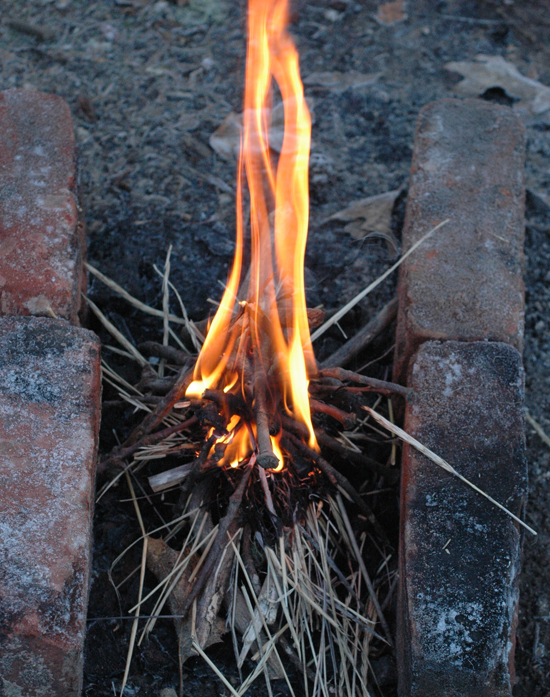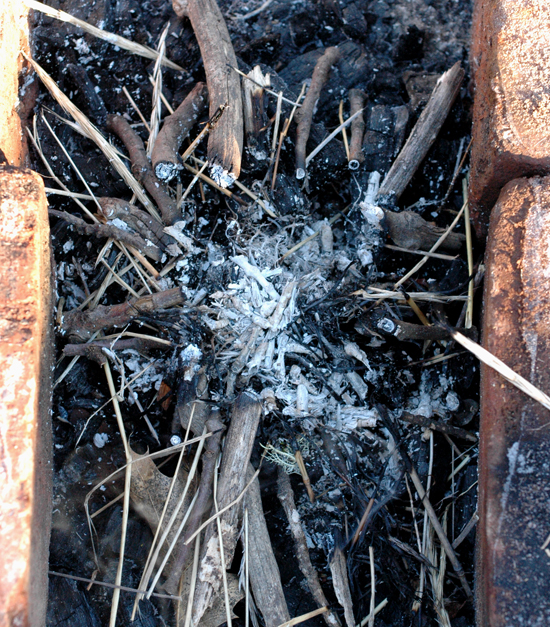"Ultimately, I think that where all of this analysis leads to is that..."
When I began writing the post, There's More to Fire Than Heat, Fuel and Oxygen (or, Fire Exists Within a Sphere of Changing and Interdependent Circumstances), I wanted a basic model to represent fire. There is actually already a model commonly used to represent fire known as the tetrahedron of fire. It consists of a tetrahedron of course, which is a pyramid with 3 sides and a bottom. The three sides represent one each of HEAT, FUEL and OXYGEN. The bottom of the pyramid represents the circumstances under which those three elements interact and is commonly referred to as a chain reaction. The common explanation of the tetrahedron is that if you remove any one of the factors represented by the four sides, the fire ceases, which is true. I have never felt comfortable with this common model, and indeed part of the impetus for writing that first article was to emphasize the importance, to my way of thinking, of the circumstances which allow, inhibit, and shape the character of, a fire; In other words, to draw what I feel is rightful attention to the bottom of the pyramid. What I ended up writing instead, or before I got to my point, was the epic analysis that follows! I decided that I better just cut it out and use it somewhere else. Lucky you.
I have a number of problems with the basic tetrahedron of fire model, but I think that many of them are due to my perspective as someone who has used fire quite a lot and would like to communicate information about starting and maintaining wood fires to other people. I feel that from this perspective the tetrahedron model doesn't emphasize the factors associated with an uninhibited chain reaction… or, especially, the actual means of controlling those factors to manipulate a fire into doing what it is that we want it to do. In fact, being on the bottom with no real name, I feel that the fourth side of the tetrahedron is actually de-emphasized in the tetrahedron, although, you could see it as the foundation I suppose. What I would like to see, is a model that demonstrates to some degree, visually as well as with a suitable name, the physical reality of fire. I guess I feel that the tetrahedron is so abstracted and theoretical that it is not of immediate practical use to most people. What I probably want is a model that is functional for fire users. This model would show the interaction of the 3 elements of fire and emphasize that it is the chain reaction itself that is really the most important factor. Yes its true that if you remove one side of the tetrahedron the fire goes out, but what of the complex interactions between the four sides which can cause a fire to burn, smolder or grow exponentially.
Fire is not a phenomenon that exists in a black and white world of burning or not burning. Of course it can be reduced to that level of understanding, but that perspective is of limited use. Rather, fire exists in a spectrum from the smallest smoldering spark to an inferno or even an explosion. Even when wood is heated below the point of combustion it undergoes destruction. Upon close scrutiny, what we really see is a spectrum with a few discreet, sensational points of especial interest, and not an all or nothing sort of situation. In other words, the limited on/off switch simplicity of the tetrahedron model limits its usefulness in a qualitative sense. When asked “what kind of fire” the tetrahedron simply says one that burns, or does not burn. The other three necessary elements exist all around, but putting them together in the proper circumstances for combustion is much more rare. I baked a pie today. There was heat in the oven, the kitchen is largely made of fuel, and air is everywhere, yet the fire stayed in the oven. Even the pie, in close proximity with a fairly energy dense flammable crust was just baked and not burned. Having heat, oxygen and fuel does not necessarily mean fire.
The tetrahedron model doesn't say much to me. I would like to come up with a model that is more immediately accessible. Also, I mean accessible to all people. Something that will say more about the process and requirements of fire at a glance with less need for elaboration. This may be an impossible task if all forms of fire are represented. The tetrahedron is simple enough that it doesn't specify anything and therefore can include all types of fires. A model that is more functional might limit the types of fires represented, but in the interest of communicating information that might be useful to those who use, or would like to use, fire.
My main complaints with the standard tetrahedron are as follows
The fourth side doesn't have a name that really works. It is usually referred to as the chemical reaction or the uninhibited chain reaction. I've racked my brain (and plied the thesaurus) and the most descriptive word I can come up with is circumstances not very immediately understandable maybe and not very sexy, but… Perhaps it needs more than one word? At least circumstances leaves room for attributes of various individual fires Either way it still begs description which is un-ideal. I think being on the bottom also contributes to the minimization of circumstances in the tetrahedron model, and that feels wrong because circumstance is really what fire is all about. To my mind the concept of circumstances should be at the center of the discussion and of the model because the other three elements are exceedingly common and even throwing them together haphazardly will not always yield fire.
The tetrahedron model doesn't foster any kind of understanding of what our relationship with fire can be as users. It exists more in a theoretical framework where extrapolations have to be made, or much more data added, to understand fire functionally. In other words, its hard to look at it and recognize anything. It doesn't foster an understanding by its nature and says almost nothing on its own.
There is not even a hint at quantity in the model. If I add more air the chain reaction is intensified. If I limit air the fire may be either put out or it may be minimized. It will die out with X amount of air in one set of circumstances and not another, and the same can be said for heat as well. The variability of fire or its reaction to partial removal or addition of one or more elements is not represented.
A much greater grasp of fire can be had by understanding the spatial distribution of fuels, which the model does not address. This goes for both the distance between fuel units (also dependent on fuel size and qualities) as well as the vertical and horizontal alignments. This point is much more relevant to solid fuels.
The behavior of the elements of heat and air are also missing from the tetrahedron model. Draft, and the build up of heat between the fuel units, are crucial factors in understanding the behavior and manipulation of fire. It would also be nice if our model could hint at this behavior.
All of the above hint at the concept that reactions of fire are complex and interdependent. Change one element in quantity or quality and the others change as well. An ideal practical model would represent in some way the interdependence and interaction between the three elements.
Maybe this is all too much to ask from a fire model! I guess I have to give the tetrahedron a couple of points here. It is kind of neato that there is this geometric model where A, H & F each touch both of the other two and the bottom touches all three. But on second thought, the chain reaction (oops, I meant circumstances), being less concrete than the others should probably be set apart as different than the other three and of course you already know I'm not happy about it being placed at the bottom as I feel this minimizes its importance. The problem I've run into in trying to improve the model though is that if you separate the three it becomes difficult or impossible to draw the connections between the other three. That is a place where the tetrahedron works.
Another possible merit of the tetrahedron is that it’s simple enough to include all types of fires… but… its too damn simple. It just doesn't say anything. Without explanation it's just a pretty shape, and you can explain what it's capable of actually showing in a few seconds.
The challenge in creating a useful fire model or diagram is to make it say something, and to communicate important information easily without confusion. Some information may have to be left in the dust, and that's fine. I want a model that can foster as much understanding as possible while still being functional and accessible. I've tried to work on such a model, but so far I'm not very happy with any of the results. In fact, I haven't yet decided whether they are even an improvement at all.
Ideally the model would represent:
draft… the crucial fact that burning things and rising heat draw more air into the firesphere.
The focal areas of heat that build up between fuel bodies and how this interaction perpetuates a fire.
The effect of the relationship between fuel sizes and the distance between fuel units on combustion.
fire as a product of the interaction of the Heat, Fuel and Oxygen and the fact that this interaction is widely variable depending on the circumstances.
Ultimately, it would actually require many diagrams and much explanation to show the more practical everyday physical realities and concepts of fire, but it would be nice if one primary and more encompassing model showed something immediately useful other than “it takes these three things to make a fire”…. and then as an afterthought, “oh yeah, they have to be uninhibited”…. and “if you take one away it stops”. What about "if you take some of this away it slows down but doesn't stop"?… or "if you add more it goes faster"?
The quest for a better fire model may be a lost cause, and for now, I've given up. I think my main beef with the tetrahedron is subjective, and simply that it seems to infer less importance to the things that really matter in practical fire applications; the things that I’m always trying to communicate to people as very important to working understanding of fires, and which I can see that many people have a poor grasp of. Ultimately, I think that where all of this analysis leads to is that an actual fire makes the best model! Imagine that! I mean it's interactive, three dimensional and fun! Perhaps we can only learn so much with two dimensional models, and will never understand fire by surfing the internet. With a fire in front of us, and a little nurturing by someone competent with fire, a rapid understanding of the circumstances of combustion is possible. And I’ve seen this over and over again when playing fire chess. Immersion is generally the best teacher. Put ourselves in circumstances which require competence and competence is fostered. Hey, stop surfing and start burning!
http://www.youtube.com/watch?v=3UmC6acEHk0








